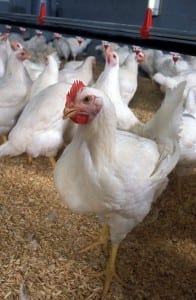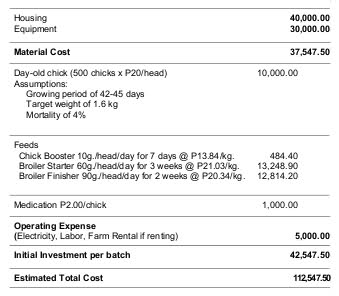Chicken broiler production is one of the most progressive animal enterprises in the Philippines today.
The poultry industry began as a backyard enterprise but has shifted to the formation of very large integrated contract farming operations.
This post will guide you on how to start your own poultry farm business.

I. Estimated Investment Cost

II. Selection of Stock to Raise
• Stock should be purchased from a reliable hatchery or dealer where the parent stocks are well housed and well managed.
• Select/buy only healthy chicks (i.e. dry, fluffy feathers, bright eyes, and alert and active appearance; free from diseases, and abnormalities; chicks should have uniform size and color; and in the case of broiler chicks, it should be less than 33 g. at day- old)
• Choose those that have high livability and are fast growers.
III. Rearing of the Day-Old Chicks
• Provide sufficient artificial heat to keep day-old chicks warm during the day and night. Avoid abrupt changes in brooder temperature during the first two weeks of life.
• Provide adequate space for chicks as they grow. Overcrowding is one of the factors affecting poor growth. Good ventilation also helps avoid future respiratory diseases. Also, provide a good light source as a well-lighted brooder encourages chicks to start feeding.
• Provide the chicks with good quality feeds either home grown or commercially sourced. Feed the chicks intermittently rather than continuously. Research studies have shown that chicks utilize nutrients better when using intermittent feeding. Do not allow feed troughs to go empty for more than 1-2 hours.
• Cleanliness and dryness of the brooding quarters will prevent chicks’ contamination from parasites and diseases, which might have been carried by previously brooded chicks.
• Environment should be kept as uniform as possible. Sudden changes in the surroundings cause a certain degree of stress or insecurity (e.g. removal of brooder canopy; slamming doors of brooder houses; or the presence of drafts). It is advisable that a regular caretaker feed the chicks following a definite schedule during the first three weeks of the chick’s life.
• Make sure that feeds and fresh water are always available.
Vitamins, minerals, and antibiotic supplements may be added to the drinking water during the first few days. Consult your feed dealer.
• Always check the chicks at night before going to sleep.
• All weak, deformed, and sickly chicks should be culled right away and disposed of properly.
• The immediate burning or burying of dead birds is an important part of a good sanitation program. Do not expose to flies or rats.
IV. Rearing of the Growing Stock
• Broilers are marketed when they reach 45-60 days of age depending on strain.
• Birds are given anti-stress drugs, either in the feed or in the drinking water, 2-5 days before and after they are transferred to the growing houses.
• Thoroughly clean and disinfect the growing houses prior to the transfer of the growing stock. Transfer birds only during good weather.
• During summer, birds’ appetite diminishes but this may be sufficiently restored by wet mash feeding or by taking appropriate measures like spraying, misting, or sprinkling the roofing with water to lower house temperature.
V. Housing
Chickens, being warm blooded, have the ability to maintain a rather uniform temperature of their internal organs. However, the mechanism is efficient only when the ambient temperature is within certain limits. Birds cannot adjust well to extremes; therefore, it is very important that chickens be housed, cared and provided with an environment that will enable them to maintain their thermal balance.
• If possible, the length of the broiler house should run from east to west. This prevents direct sunlight from penetrating the side walls of the house, which could cause heat build-up inside.
• Ventilation is very important. Allocate at least 1 square foot of floor space per bird.
• If constructing an open-sided type of housing, elevate the house about 1.5 m. from the ground. This ensures proper circulation of air and easier collection of fecal matter underneath the house after each harvest.
• The building should be rat proof, bird proof, and cat proof.
• Trees may be planted on the sides of the house to provide shade during hot season. These can also serve as protection from storms or weather disturbances.
• The roofing should be monitor-type and high enough to provide better air circulation inside the broiler house.
• In preparation for the arrival of the chicks, thoroughly clean the house with the use of a high pressure washer to remove dust, fecal matter, or any debris inside. Disinfect the house and all equipment to be used.
VI. Location Requirements and Recommended Layout for Poultry Farms
• A poultry farm must be located outside urban areas.
• It must be located in 25 m. radius from sources of ground and surface drinking water.
• Medium and large poultry farms must be at least 1,000 m. away from built-up areas (residential, commercial, institutional and industrial) while a small scale must be at least 500 m. away from these areas.
VII. Feeding Management
• Broiler-commercial rations are fed to the birds during the first 5 weeks and from then on are replaced by the broiler-finisher ration.
• All purpose straight broiler ration is fed from the start to the marketing age of eight weeks.
• Commercial broiler feeds contain additives considered to be grown-promoting substances. Feed additives make broiler production profitable and help broiler farmer control diseases.
VIII. Health Management
• The most economical and ideal method to control diseases could be achieved by proper management, good sanitation, and having an effective vaccination program. Consult a veterinarian for a program suited to your business operation.
IX. Marketing
• Alternative market outlets should be surveyed even before deciding to start a broiler business to ensure a ready market at the time of harvest. Marketing arrangements with local hotels, restaurants, cafeterias, institutional buyers, and grocery stores with freezers may be made.
• Producers may form associations or market cooperatives so that they could agree on a common price. Organized producers have bargaining power with regard to their selling prices.
• Producers are advised to compute which is more profitable to sell, the birds dressed or live, and whether to sell at the farm or in the market.
• The broilers should be sold at optimum weight (1.6-1.9 kg. live weight).
X. Estimated Income per Batch (42-45 days)
-Net of 4% mortality rate
— Based on DA-BAI figures as of Feb 2, 2009
XI. Ecological Implications
Livestock production impacts on the environment through possible effects on surface and ground water quality, gas emissions from animal wastes, and unpleasant odors arising from the enterprise.
Manure management is less problematic in poultry enterprises, where manure management does not usually entail wet disposal as in piggery enterprises, and where the chicken dung is often routinely collected for conversion into organic fertilizer or fish feeds.
Gases emitted in livestock enterprises include ammonia, carbon dioxide, methane, and nitrous oxide. The latter three contribute to atmospheric changes that lead to global warming. Unpleasant odors emanating from a livestock enterprise are a function of the scale of operation and sound manure management.
It is likely that the increasing scale of operation in livestock enterprises in the past years has also intensified the adverse environmental impacts of the industry. The challenge is to constantly develop more efficient and effective technologies for managing animal wastes tailored to different scales of production, even as various means of converting such wastes to useful products (e.g. biogas, fertilizer) have been in use for many years.
XII. Registration Requirements
1. Business Name Registration
From the Department of Trade and Industry (DTI) provincial office of the province where the business is located
Validity: 5 years
2. Barangay Clearance
From the barangay office, which has jurisdiction over the area where the business is located
3. Mayor’s Permit and License / Sanitary Permit
From the local government which has jurisdiction over the area where the business is located
Validity: 1 year
4. Tax Identification Number (TIN)
From the Bureau of Internal Revenue (BIR) National Office
Diliman, Quezon City or from the nearest BIR Office in your locality
5. Environmental Compliance Certificate
Department of Environment and Natural Resources (DENR)
Visayas Avenue, Diliman, Quezon City
Telephone No.:: (632) 929.6626
XIII. Financing
Agricultural Credit Policy Council (ACPC)
28/F, One San Miguel Avenue Building
San Miguel Avenue, Ortigas Center Pasig City
Telephone Nos.: 634.3326 / 634.3320 to 21
Telefax: 636.3393
Land Bank of the Philippines (LBP)
Head Office: 1598 M. H. Del Pilar cor. Dr. J. Quintos Sts.
Malate, Manila
Telephone Nos.: 522.0000 / 551.2200
Development Bank of the Philippines (DBP)
Head Office: Sen. Gil J. Puyat Avenue cor. Makati Avenue
Makati City
Telephone No.: 818.9511 (connect to SME Department)
XIV. Technical Assistance
Department of Agriculture
Bureau of Animal Industry (DA-BAI)
Visayas Avenue, Diliman, Quezon City
Telephone No.: (632) 926.6883
Fax No.: 927.0971
Technology Resource Center (TRC)
TRC Building,103 J. Abad Santos cor. Lopez Jaena Sts.,
Little Baguio, San Juan City (Near corner Wilson Street)
Telephone No.: (632) 727.6205
Philippine Association of Broiler Integrators, Inc. (PABI)
c/o San Miguel Foods, Inc.
18/F, JMT Building, ADB Avenue, Ortigas Center, Pasig City
Telephone No.: 634.1010
Telefax: 637.3786
Download here the Manual on Chicken/Poultry Raising Guide.
Source: www.dti.gov.ph, Oct 2009. ldc.da.gov.ph
BUREAU OF MICRO, SMALL AND MEDIUM ENTERPRISE DEVELOPMENT (BMSMED)
5/F, Trade and Industry Building
361 Sen. Gil J. Puyat Ave. Makati City
Tel. Nos.: (02) 897.1693 / 897.7596 / 890.4968
Fax No.: (02) 896.7916
Email: bmsmed@dti.gov.ph

Hello,
If you want to go into poultry farm business, There are so many company website this days like http://www.virtatrade.com that will enable you as a beginner to raise the fund you need to start up your poultry farm business without you seeking for a loan.
This company is where many business dealers from all over the world generate fund that backup their various businesses financially.
I used this company to backup my cocoa beans export business each time my business is running down.
You can visit and register with the company website here http://www.virtatrade.com to raise the fund you need now to go into your poultry farm business.
Thank you for this nice business idea!
Where can i buy good quality chick in batangas area?
Nice one. Helps a lot
Joe M Tes sir, have you started your poultry farm? If yes, how is it going?
Dios mabalos kan saindong pagdogang kan impormasyon sako, y lugod pa man mkatabang pa kamu sa mga nangangaipong arog ko….y lubos pa man mkatabang kamu sa asistencia pinansyal…ta mkautang basang!!!
APA FORMAT of author.
Thanks
I'm also trying to open up my own poultry farm in the far northern part of the country. In retrospect, would you still have started the business? From what the article suggests, this business venture seems very plausible for a stateside based entrepreneur.
thank you for the information
thank you for giving me an idea for raising broilers
thank you for the informations
I appreciate the references for technical assistance – This is not as simple as it looks. After building 2 houses for a 20,000 capacity we are working as a contract grower for Danway 8 grows later only 2 have been profitable the others barely break even if there was a bank loan we would be very negative. Working on solutions possibly no contract and producing our own feeds. All options are much more investment of money and time
thank you for giving us ways and infomative ideas of raising broilers. God bless.
interesting
thank you
tnx…
its me
informative
its